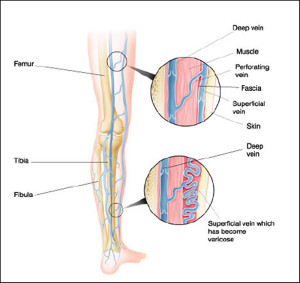Venous Anatomy
Varicose & Spider Vein Treatment Morristown, NJ
Vein disease, which is the primary cause of varicose veins, occurs when veins have trouble carrying blood from your body back to your heart. The main cause is heredity. You are at higher than average risk if your mother or grandmother – or even someone on your father’s side – suffers from serious vein problems. And, due to pregnancy, women are more often affected than men. The first sign of vein disease is often tired, heavy feeling legs. This is a clear indication that the return flow of blood from the legs to the heart is impaired. If these early complaints are not taken seriously, it’s not long before the discomfort may be accompanied by swelling (edema) of ankles and lower legs – a sign that the blood has become congested in the leg veins. You may find that the problem is more pronounced after a day of prolonged sitting or standing. That’s because the leg veins damage easily and may become enlarged by the pressure of the pooled area. As the vein walls become weaker, they may start to leak fluid into the surrounding tissues, and the swelling increases. Two distinct and common complications as a result of venous insufficiency are varicose veins and spider veins. Both of these progressive conditions create cosmetic concerns, but they can develop into serious medical issues as well.


Varicose Veins
Varicose veins are enlarged, twisted rope-like veins appearing near the surface of the skin. While they can develop anywhere in the body, they are most commonly found in the legs and ankles because standing and walking increase pressure in the lower extremities. In normally functioning veins, tiny one-way valves open as blood flows toward the heart and close to prevent blood from flowing backward. When these valves malfunction, blood pools in the veins, resulting in a buildup of pressure that weakens their walls and causes them to bulge. Over time, the increased pressure can cause additional valves to fail. This venous reflux, or venous insufficiency, leads to the development of varicose and spider veins.
Spider Veins
Spider veins (telangiectasias) are similar to and often associated with underlying varicose veins, but there are some major differences. Spider veins are smaller in size, beginning as tiny red capillaries that lie close to the surface of the skin and are easily visible. Spider veins are most commonly found on the thighs, calves, ankles or face, where they often become a cosmetic concern. They can also cause physical symptoms ranging from aching, heaviness and itchiness to night cramps. Not all spider veins require treatment, particularly if they are not causing pain or other physical symptoms. However, some people decide to have them removed for cosmetic reasons, and treating these veins early could prevent worsening symptoms associated with venous reflux disease. Because vascular disease is progressive, it is important to treat the underlying cause of the disease early to prevent such complications as hyperpigmentation, venous ulcers, edema, and increased risk of deep vein thrombosis (DVT) or pulmonary embolism (PE) – a potentially life threatening condition.
